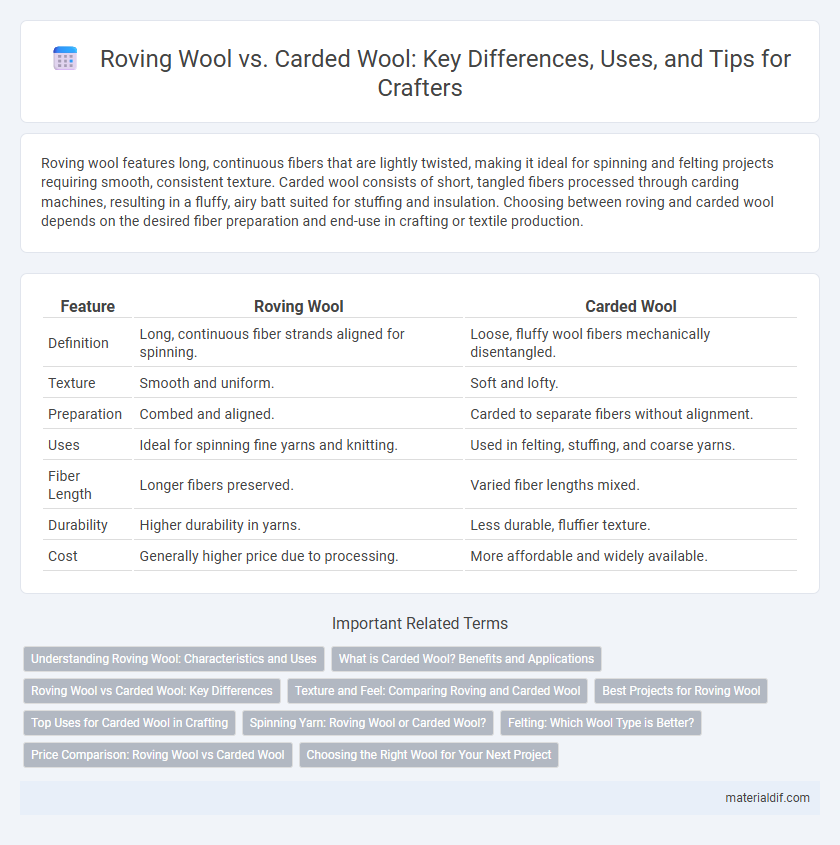Roving wool features long, continuous fibers that are lightly twisted, making it ideal for spinning and felting projects requiring smooth, consistent texture. Carded wool consists of short, tangled fibers processed through carding machines, resulting in a fluffy, airy batt suited for stuffing and insulation. Choosing between roving and carded wool depends on the desired fiber preparation and end-use in crafting or textile production.
Table of Comparison
| Feature | Roving Wool | Carded Wool |
|---|---|---|
| Definition | Long, continuous fiber strands aligned for spinning. | Loose, fluffy wool fibers mechanically disentangled. |
| Texture | Smooth and uniform. | Soft and lofty. |
| Preparation | Combed and aligned. | Carded to separate fibers without alignment. |
| Uses | Ideal for spinning fine yarns and knitting. | Used in felting, stuffing, and coarse yarns. |
| Fiber Length | Longer fibers preserved. | Varied fiber lengths mixed. |
| Durability | Higher durability in yarns. | Less durable, fluffier texture. |
| Cost | Generally higher price due to processing. | More affordable and widely available. |
Understanding Roving Wool: Characteristics and Uses
Roving wool is a long, narrow bundle of fiber that has been carded and slightly twisted, making it ideal for spinning yarn, felting, and weaving due to its smooth texture and consistent thickness. Unlike carded wool, which remains in a fluffy, loosely arranged state, roving wool offers greater control and strength, enabling crafters to produce uniform threads and durable textiles. Its characteristics include enhanced fiber alignment and minimal air pockets, which contribute to improved fiber cohesion and ease of handling during the spinning process.
What is Carded Wool? Benefits and Applications
Carded wool is processed by brushing raw wool fibers to align them loosely while removing impurities, resulting in a fluffy, uneven texture ideal for spinning or felting. Benefits include enhanced fiber cohesion, improved softness, and increased ease of dye absorption, making it suitable for textiles, insulation, and crafting applications. This type of wool supports versatile use in garments, blankets, and eco-friendly home decor due to its breathability and natural warmth.
Roving Wool vs Carded Wool: Key Differences
Roving wool is a long, soft, and slightly twisted strand of fiber ideal for hand spinning and felting projects, offering smoother texture and consistent thickness compared to carded wool. Carded wool consists of fibers that have been brushed and aligned but remain fluffy and loose, making it perfect for blending colors and creating bulkier, textured yarns. The key differences lie in texture, fiber alignment, and end-use, with roving wool providing a more uniform and durable material while carded wool emphasizes versatility and volume.
Texture and Feel: Comparing Roving and Carded Wool
Roving wool features a smooth, soft texture with long, continuous fibers that create a silky feel ideal for spinning fine yarns. Carded wool, by contrast, has a fluffier, more uneven texture due to its shorter, loosely aligned fibers, resulting in a loftier and warmer material. The tactile difference makes roving wool preferable for delicate projects, while carded wool suits bulkier, textured crafts.
Best Projects for Roving Wool
Roving wool features long, continuous fibers ideal for spinning and felting, making it perfect for delicate projects like hand-spun yarn, needle felting, and wet felting crafts. Its smooth texture and consistent thickness ensure even thread production, enhancing durability in knitted garments and accessories. Compared to carded wool, which has shorter fibers and a fluffier texture suited for stuffing and weaving, roving wool excels in precision-based fiber art projects requiring strength and flexibility.
Top Uses for Carded Wool in Crafting
Carded wool, characterized by its fluffy and loosely aligned fibers, is ideal for felting, spinning, and needlework projects requiring a soft texture and enhanced fiber blending. It excels in creating durable, warm garments and accessories such as scarves, mittens, and hats that benefit from its slightly irregular fiber arrangement. Crafters often favor carded wool for decorative arts and mixed-media crafts due to its versatility and ease of dye absorption.
Spinning Yarn: Roving Wool or Carded Wool?
Roving wool is preferred for spinning yarn due to its long, continuous fibers aligned in parallel, which creates a smoother and stronger yarn ideal for hand spinning and weaving. Carded wool, made from shorter, more tangled fibers, results in a bulky, airy texture better suited for felting or chunky yarn rather than fine, durable threads. Choosing roving wool over carded wool enhances fiber consistency and yarn quality for textile projects requiring precision and strength.
Felting: Which Wool Type is Better?
Roving wool, with its aligned and compact fibers, felts more efficiently than carded wool, which has a looser and more airy fiber structure. The dense arrangement in roving wool allows the fibers to interlock quickly, creating a smoother and stronger felted fabric. Carded wool, while softer and fluffier, requires more agitation and time to achieve the same level of felting quality.
Price Comparison: Roving Wool vs Carded Wool
Roving wool typically costs more than carded wool due to its higher quality and added processing steps like combing for smoother fibers. Carded wool is less expensive as it undergoes only a basic cleaning and carding process, resulting in a coarser texture suitable for bulkier projects. The price difference reflects the intended use, with roving wool favored for finer spinning and knitting, justifying its premium cost.
Choosing the Right Wool for Your Next Project
Roving wool offers smooth, continuous fibers ideal for spinning fine yarns and creating durable textiles, while carded wool provides a fluffy, airy texture suited for felting and bulkier crafts. Selecting the right wool depends on your project requirements; roving wool enhances strength and uniformity, whereas carded wool delivers softness and volume. Consider the fiber alignment and end-use to ensure the best performance and aesthetic for your handmade creations.
Roving Wool vs Carded Wool Infographic

 materialdif.com
materialdif.com